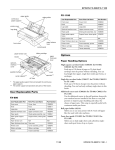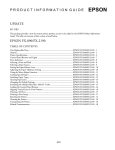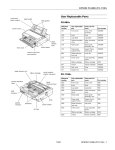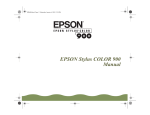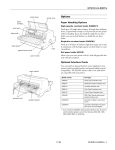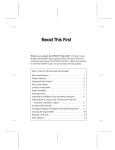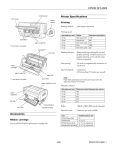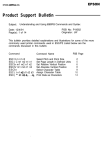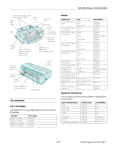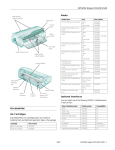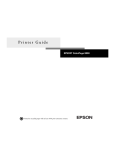Download Epson LQ-570e Specifications
Transcript
EPSON LQ-570e edge guides User Replaceable Parts paper guide paper guide cover User replaceable part printer cover paper release lever front cover (closed) control panel Part number Upper connector cover 1037223 C.B.S-tite screw 1002674 Front edge guide 1050231 Front cover assembly 1053455 Knob 1039337 Logo plate 1053118 Paper separator 1025296 Paper eject assembly 1050319 Printer cover assembly 1050320 Rear tractor assembly 1040231 Rear sheet guide assembly 1050324 Options Paper Handling Options High-capacity cut-sheet feeder (C806381) ribbon cartridge shield plate paper thickness lever (gap) Feeds up to 150 sheets of paper or 25 plain bond envelopes into the printer without reloading. If you also install the single-bin cut-sheet feeder, you can use both feeders as a double-bin cutsheet feeder. Single-bin cut-sheet feeder (C806371) Feeds up to 50 sheets of ordinary single-sheet paper and is used in conjunction with the high-capacity cut-sheet feeder to create a double bin. knob Additional tractor unit (C800201) parallel interface Used in combination with the other tractor, improves continuous paper handling and reduces the chance of paper jams. This is especially useful for printing on continuous multipart forms. tractor paper tension unit Roll paper holder (#8310) Allows you to use your printer with 8.5-inch roll paper like that used with telex machines. Front sheet guide (C814231) Allows you to easily load single sheets, including single sheet mulitpart forms, from the front paper slot. front edge guide front cover (open) 4/00 EPSON LQ-570e - 1 EPSON LQ-570e Optional Interface Cards Printing direction You can install an optional interface card to supplement your printer’s built-in parallel interface and provide added network compatibility. The EPSON interface cards in the table below are compatible with your printer. Bidirectional logic seeking for text and graphics printing. Unidirectional text or graphics printing can be selected using software commands. Line spacing 1/6 inch or programmable in 1/360-inch increments Printable columns 80 columns (at 10 cpi) Model number Card type C823051 Serial Type B interface card C823071 32KB serial Type B interface card C823121 LocalTalk interface card C823141 Coax Type B interface card C823151 Twinax Type B interface card C823451 IEEE-1284 (Type B bidirectional) parallel interface card C823622 Type B Ethernet interface card for 10 Base 2 / 10 Base T C823642 Type B Ethernet interface card for 10/100 Base TX with AC adapter Resolution (maximum) Letter quality: 360 × 180 dpi Raster graphics: 360 × 360 dpi Interfaces 1 standard bidirectional, 8-bit parallel interface with IEEE-1284 nibble mode support, and 1 optional interface slot Paper feed methods Friction (front or top paper entry) Push tractor (rear paper entry) Pull tractor (front, bottom, or rear paper entry) * If you install the C823051 optional serial interface card, be sure to set the transfer speed to one of the following: 300, 600, 1200, 2400, 4800, 9600, or 19200 bps. Push and pull tractor (optional) High-capacity cut-sheet feeder (optional) Printer Specifications Roll paper holder (optional) Paper feed speed Mechanical Printing method 24-pin impact dot matrix Emulation EPSON ESC/P®2 and IBM 2390 Plus Printing speed High-speed draft 400 cps at 10 cpi Continuous 5 inches/second Intermittent 45 ms/line at 1/6-inch line spacing Paper capacity Draft 300 cps at 10 cpi 360 cps at 12 cpi 450 cps at 15 cpi Optional high-capacity cut-sheet feeder up to 150 sheets of 22 lb (82 g/m2) paper up to 25 plain or bond envelopes up to 30 airmail envelopes up to 30 postcards Single-bin cut-sheet feeder up to 50 sheets of 22 lb (82 g/m2) paper Draft condensed 257 cps at 17 cpi 300 cps at 20 cpi The total thickness of the paper stack can be up to 0.20 inch (5 mm). LQ 100 cps at 10 cpi 120 cps at 12 cpi 150 cps at 15 cpi LQ condensed 171 cps at 17 cpi 200 cps at 20 cpi 2 - EPSON LQ-570e Buffer 4/00 64KB EPSON LQ-570e Built-in fonts Ribbon EPSON Draft 10, 12, 15 cpi Black ribbon cartridge (#7753) Film ribbon cartridge (#7768) EPSON Roman 10, 12, 15 cpi, proportional Black ribbon life: 2 million characters (LQ, 10 cpi, 48 dots/character) EPSON Sans Serif 10, 12, 15 cpi, proportional Film ribbon life: 0.2 million characters (LQ, 10 cpi, 48 dots/character) Bitmap fonts EPSON Courier 10, 12, 15 cpi EPSON Prestige 10, 12 cpi Electrical EPSON Script 10 cpi 120 V EPSON OCR-B 10 cpi Input voltage range EPSON Orator 10 cpi EPSON Orator-S 10 cpi EPSON Script C proportional 50 to 60 Hz Input frequency range 49.5 to 60.5 Hz EPSON Roman T 10.5, 8–32 pt (every 2 pt) EPSON Sans Serif H 10.5, 8–32 pt (every 2 pt) Barcode fonts 1.0 A (maximum 2.6 A depending on the character type) Power consumption Approx. 36 W (ISO/IEC 10561 letter pattern) Temperature Humidity (without condensation) Operation 41 to 95 °F (5 to 35 °C) 10 to 80% RH Storage –22 to 140 °F (–30 to 60 °C) 0 to 85% RH Paper EAN-13, EAN-8, Interleaved 2 of 5, UPC-A, UPC-E, Code 39, Code 128, POSTNET Use recycled paper and envelopes only under normal temperature and humidity conditions, as follows: Temperature Humidity 1 Italic table and 12 graphical character tables (35 graphical character tables are available in some countries) Character sets 14 international character sets and 1 legal character set Reliability Total print volume 19 million lines (except print head) MTBF 10,000 POH (25% duty) Height 6.3 inches (160 mm) Width 16.3 inches (415 mm) Depth 14.5 inches (368 mm) Weight 16.5 lb (7.5 kg) 59 to 77 °F (15 to 25 °C) 30 to 60% RH Do not load paper that has been folded or is damaged, wrinkled, or curled. Ordinary single sheets: front, top, and cut-sheet feeder entry Width Front and top 10.1 to 14 inches (257 to 356 mm) High-capacity cut-sheet feeder 3.9 to 14.3 inches (100 to 364 mm) Second bin cut-sheet feeder 7.2 to 8.5 inches (182 to 216 mm) Length Front and top 3.9 to 14.3 inches (100 to 364 mm) High-capacity cut-sheet feeder 10.1 to 14 inches (257 to 356 mm) Second bin cut-sheet feeder 10.1 to 14 inches (257 to 356 mm) Print head life approximately 200 million strokes per wire Dimensions and weight 0.5 A (maximum 1.4 A depending on the character type) Rated current Environmental EPSON Sans Serif 10.5, 8–32 pt (every 2 pt) Character tables 198 to 264 V Rated frequency range Scalable fonts EPSON Roman 10.5, 8–32 pt (every 2 pt) 220 to 240 V 99 to 132 V 4/00 EPSON LQ-570e - 3 EPSON LQ-570e Thickness 0.0025 to 0.0055 inch (0.065 to 0.14 mm) Cut sheet feeder: 0.0028 to 0.0055 inch (0.07 to 0.14 mm) Weight 14 to 24 lb (52 to 90 g/m2) Cut sheet feeder: 18 to 24 lb (64 to 90 g/m2) Single-sheet multipart forms: front entry only Width 3.9 to 10.1 inches (100 to 257 mm) Length 3.9 to 14.3 inches (100 to 364 mm) Copies 1 original + up to 4 copies Thickness 0.0047 to 0.015 inch (0.12 to 0.39 mm) Weight 12 to 15 lb (40 to 58 g/m2) Binding Line glue at the top of form ❏ The continuous multipart forms should be securely joined together along the left and right edges by crimping. Crimping should be pressed in from the original sheet side and go completely through all copy sheets. ❏ The ratio of the cut/uncut length at the perforation should be between 3:1 and 5:1. ❏ The perforation between pages should not extend all the way to the edges of the paper. ❏ At the perforation between pages, the horizontal and vertical perforation cuts should not cross. ❏ The thickness of the perforation part when extended should be 1 mm or less. Continuous paper with labels: front and bottom entry Label size (minimum) 0.938 × 2.5 inches (23.8 × 63.5 mm) 0.1 inch (2.5 mm) corner radius Backing sheet width 4 to 10 inches (101.6 to 254 mm) Backing sheet length 4 to 22 inches (101.6 to 558.8 mm) Backing sheet thickness 0.0028 to 0.0035 inch (0.07 to 0.09 mm) Total thickness Front and top: 3.9 to 7.9 inches (100 to 200 mm) Cut sheet feeder: 3.9 to 5.8 inches (100 to 148 mm) 0.0063 to 0.0075 inch (0.16 to 0.19 mm) Label weight 17 lb (64 g/m2) Length Front: 5.8 to 7.9 inches (148 to 200 mm) Top: 3.9 to 7.9 inches (100 to 200 mm) Cut sheet feeder: 3.9 to 5.8 inches (100 to 148 mm) Roll paper: rear entry with optional roll paper holder only Thickness 0.0087 inch (0.22 mm) Weight 51 lb (192 g/m2) Envelopes: top entry only 6.5 × 3.6 inches (165 × 92 mm) 9.5 × 4.1 inches (241 × 105 mm) Size No. 6 No. 10 Thickness 0.0063 to 0.0205 inch (0.16 to 0.52 mm) Weight 12 to 24 lb (45 to 90 g/m2) Postcards: front and top entry Width Width 8.5 ± 0.12 inch (216 ± 3 mm) Thickness 0.0028 to 0.0035 inch (0.07 to 0.09 mm) Weight 14 to 22 lb (52 to 82 g/m2) Continuous paper (standard and multipart): front, rear, and bottom entry Paper Alignment Width 4 to 10 inches (101.6 to 254 mm) Front entry Length 4 to 22 inches (101.6 to 558.8 mm) Copies 1 original + up to 4 copies Printing starts at “0” on the scale. The unprintable area is to the left of the “0”. Thickness Printable area 0.0025 to 0.015 inch (0.065 to 0.39 mm) Perforated edges up to 0.035 inch (0.9 mm) Weight (not multipart) 14 to 22 lb (52 to 82 g/m2) Weight (1 multipart sheet) 12 to 15 lb (40 to 58 g/m2) Binding Point glue or paper staples on both sides (front, bottom, or rear entry) 4 - EPSON LQ-570e 4/00 EPSON LQ-570e Rear entry Continuous paper Printing starts at “0” on the scale. The unprintable area is to the left of the “0.” A A printable area B B A The minimum top and bottom margins above and below the perforation are 0.17 inch (4.2 mm). Printable Area Single sheets, envelopes, and postcards A B The minimum left and right margins are 0.51 inch (13 mm). The maximum paper width is 10 inches (254 mm). The maximum printable width is 8 inches (203.2 mm). For continuous paper wider than 9 inches (229.2 mm), the side margins increase proportionally to match the width of the paper. B A printable area C B Roll paper B printable area A B printable area C A The minimum top margin is 0.17 inch (4.2 mm). B The minimum left and right margins are 0.12 inch (3 mm). The maximum paper width is 10.1 inches (257 mm). The maximum printable width is 8 inches (203.2 mm). For single sheets wider than 8.23 inches (209.2 mm), the side margins increase to match the width of the paper. A The minimum top margin is 0.17 inch (4.2 mm). C The minimum bottom margin is 0.17 inch (4.2 mm). B The minimum left and right margins are 0.12 inch (3 mm). The maximum printable width is 8 inches (203.2 mm). Safety Approvals 120 V 4/00 Safety standards UL 1950 CSA C22.2 No. 950 EMI FCC part 15 subpart B class B CSA C108.8 class B EPSON LQ-570e - 5 EPSON LQ-570e 230 V Tear Off/Bin lights Safety standards EN 60950 ❏ f f when continuous paper is in the tear-off position. EMI EN 55022 (CISPR pub. 22) class B AS/NZS 3548 class B ❏ o n when bin 1 of the optional cut-sheet feeder is selected. ❏ n o when bin 2 of the optional cut-sheet feeder is selected. Acoustic noise Approx. 49 dB (A) (ISO 7779 pattern) ❏ n n when the printer is in the card mode. n = on, o = off, f = flashing CE Marking LF/FF button 230 V Low Voltage Directive 73/23/EEC EN 60950 ❏ Feeds paper line by line when pressed quickly. EMC Directive 89/336/EEC EN 55022 Class B EN 61000-3-2 EN 61000-3-3 EN 50082-1 IEC 60801-2 IEC 60801-3 IEC 60801-4 ❏ Ejects a single sheet or advances continuous paper to the next top-of-form position when held down. Load/Eject button Control Panel Buttons and Lights ❏ Loads a single sheet of paper. ❏ Ejects a single sheet of paper when a sheet is loaded. ❏ Loads continuous paper from the standby position. ❏ Feeds continuous paper backward to the standby position in micro adjust mode. Micro Adjust mode When you hold down the Pause button for 3 seconds, the printer enters the micro adjust mode. In this mode, you can press the LF/FF D and Load/Eject U buttons to adjust the top-of-form or tear-off position. Font button Pause button Selects the font. Stops printing temporarily, and resumes printing when pressed again. When pressed for 3 seconds, turns on micro adjust mode. Font lights Indicate which font is selected. Pause light Condensed button ❏ On when the printer is paused. Turns condensed mode on and off. ❏ Flashes when the printer is in the micro adjust mode or when the print head has overheated. Condensed light Paper Out light On when condensed mode is on. ❏ On when no paper is loaded in the selected paper source or paper is not loaded correctly. ❏ Flashes when paper has not been fully ejected or a paper jam has occurred. Tear Off/Bin button ❏ Advances continuous paper to the tear-off position. ❏ Feeds continuous paper backward from the tear-off position to the top-of-form position. ❏ Selects a cut-sheet feeder bin when the cut-sheet feeder is installed and the release lever is in the single sheet position. ❏ Turns on the card mode to print on postcards and envelopes. 6 - EPSON LQ-570e 4/00 EPSON LQ-570e Error Indicators Status Monitor You can identify many common printer problems using the lights on the control panel. If your printer stops working and one or more control panel lights are on or flashing, or the printer beeps, use the following table to diagnose and fix the problem. The EPSON Status Monitor 3 utility comes with the printer but is available only for use with Windows 95, 98, or NT 4.0. It allows you to monitor your printer’s status, alerts you when printer errors occur, and provides troubleshooting instructions. State of Beep panel lights pattern Problem n Pause The printer is paused. Paper Positions Solution Top-of-Form Position Press the Pause button to resume printing. The top-of-form position is where the printer starts printing on single sheets or continuous paper. Paper from another paper source is currently in the paper path. Move the paper release lever back to the appropriate position and press the Load/Eject button to feed the paper out of the paper path. Then set the lever to the position you want to use. Press the Pause button to turn off the Pause light, if necessary. n Paper Out n Pause No paper is loaded in the selected paper source. Load paper in the printer. Then press the Pause button to turn off the Pause light, if necessary. The paper is not loaded correctly. Remove your paper and reload it. Then press the Pause button to turn off the Pause light, if necessary. The letters ABC are printed at the top-of-form position Tear-off Position Paper is jammed in the printer. Clear the paper jam as described on page 14. f Paper Out n Pause Continuous paper is in the tear-off position when the perforation is aligned with the tear-off edge. You can easily tear off your printed document at this position. Continuous paper is not fed to the standby position. Tear off the printed document at the perforation; then press the Load/Eject button. The printer feeds the paper to the standby position. Press the Pause button to turn off the Pause light. Standby Position Continuous paper is in the standby position when it is attached to the tractor but not loaded in the printer. A single sheet of paper is not fully ejected. Press the Load/Eject button to eject the sheet. Then press the Pause button to turn off the Pause light, if necessary. Paper is jammed in the printer. Clear the paper jam as described on page 14. f Pause The print head is overheated. Wait a few minutes; the printer resumes printing automatically once the print head cools. f Paper Out f Pause ff Tear Off/Bin f f f Font An unknown printer error has occurred. Turn off the printer and leave it off for several minutes; then turn on the printer again. If the error recurs, contact your dealer. n = on, f = flashing ••• = short series of beeps (three beeps) ••••• = long series of beeps (five beeps) The printer beeps once if you press a control panel button when the corresponding function is not available. 4/00 EPSON LQ-570e - 7 EPSON LQ-570e Available Paper Paths Paper slot Description If you print on thick paper, such as multipart forms or continuous paper with labels, use the front paper slot because this paper path is almost straight. This reduces the chance of paper jams. The printer provides a variety of paper paths for single sheets and continuous paper. This section describes how paper feeds into the printer from the top, front, bottom, or rear. front Printing on Continuous Paper The bottom paper slot has the straightest paper path, so it is the best slot to use when printing on thick paper, such as multipart forms or continuous paper with labels. You can choose from two tractor positions (push and pull) and three paper entry slots (front, bottom, and rear) for printing on continuous paper. This section helps you determine which paper paths and tractor positions are best for your continuous paper printing needs. bottom Using the push tractor If you often need to tear off sheets of continuous paper (for printing purchase orders or sales slips, for example), it is best to use the push tractor. This allows you to use the tear-off edge to easily tear off printed sheets of continuous paper at the perforation. When continuous paper is loaded on the push tractor, you can also load single sheets from the paper guide without removing the continuous paper from the tractor. When loading paper in the bottom slot, be sure to use a printer stand with an opening large enough for the paper to feed through it without obstruction. You can also load continuous paper from the rear pull tractor position. Do not load continuous paper with labels in the rear slot; the labels may come off their backing sheet inside the printer and cause a paper jam. rear Paper loaded from the rear slot results in a curved paper path, which may affect loading performance, so use the front or bottom slot whenever possible. The tractor is installed in the push position when the printer is shipped. Using a pull tractor If you often print on thick or heavy continuous paper, such as multipart forms or continuous paper with labels, use a tractor in the pull position. The pull tractor provides the best paper jam prevention, and allows you to load continuous paper from the front, rear, or bottom of the printer. However, you cannot use the tear-off feature with the pull tractor. You can use the front, bottom, or rear paper slot with the pull tractor. Using the push and pull tractors in combination You can improve paper feeding and reduce paper jams by using two tractors at the same time. This is especially helpful for printing on continuous preprinted forms, multipart forms, and for printing high-quality graphics. If you plan to use a tractor in the pull position, you can remove the tractor from the rear push position and reinstall it in the pull position, or you can purchase an optional tractor unit (C800201) and install it in the pull position. Combination To use the push tractor with the pull tractor, you need to purchase the optional pull tractor (C800201) and install it in the pull position. rear push and pull 8 - EPSON LQ-570e Description 4/00 Do not load continuous paper with labels onto the push tractor even when it is used in combination with the pull tractor. If you load continuous paper with labels onto the rear push/pull tractor, the labels may come off their backing sheet inside the printer and cause a paper jam. EPSON LQ-570e Printing on Single Sheets Paper Release Lever Positions You can load ordinary single sheets from the top or front of the printer, even with continuous paper already loaded in the push tractor. Use the paper release lever to indicate the paper source you want to use. The table below describes each paper release lever position. Loading paper in the top slot You can load ordinary single sheets, envelopes, or postcards in the top slot. Load envelopes in the top slot only. Paper release lever position Loading paper in the front slot Description Single-sheet position For loading single sheets from the top or front slot. You can load ordinary single sheets, single-sheet multipart forms, or postcards in the front slot. Push tractor position For loading continuous paper from the tractor installed in the push position. Set the lever to this position when using the push and pull tractors in combination. Pull tractor position For loading continuous paper from the tractor on top of the printer in the pull position. When the tractor is in the pull position, you can load paper in the front, rear, or bottom slot. Always use the front paper slot to load single-sheet multipart forms. 4/00 EPSON LQ-570e - 9 EPSON LQ-570e Paper Thickness Lever Positions Paper Handling The paper thickness lever allows the printer to accommodate various thicknesses of paper. You can select one of 8 positions identified by the scale next to the lever. Loading Multipart Forms You can use carbonless multipart forms of up to 5 parts (the original plus up to 4 copies). Make sure you set the paper thickness lever to the proper position based on the number of layers in your form. For best results with multipart forms, select a straight or almost straight paper path. It is best to load multipart forms using the front or bottom slot and the pull tractor. Except for setting the paper thickness lever, load multipart forms the same way you load ordinary continuous paper. Be sure your multipart forms do not exceed 0.015 inch (0.39 mm) in thickness for the printable area and 0.03 inch (0.76 mm) for the perforated edges. Do not load paper that is damaged, curled, or wrinkled. If you are using crimp bound paper, make sure the protruding side of the crimp faces away from the print head when you print. Hitting the crimp protrusion with the print head could severely damage the print head. Loading Continuous Paper with Labels Use the following table to set the paper thickness lever to match the thickness of your paper. Paper type Lever position Ordinary (single sheets or continuous paper) 1 or 0 Carbonless multipart forms with: 2 parts (original + 1 copy) 3 parts (original + 2 copies) 4 parts (original + 3 copies) 5 parts (original + 4 copies) 1 2 3 5 Continuous paper with labels* 2 Postcard 2 Envelopes 2 to 6 When printing, use only labels that are mounted on continuous backing sheets with sprocket holes for a tractor feeder. Do not try to print on single sheets because the printer may not properly feed labels on a shiny backing sheet. Continuous paper with labels requires a straight or almost straight paper path. Be sure to use the tractor in the pull position and load the labels in the front or bottom. You load labels the same way you load ordinary continuous paper, except you must set the paper thickness lever to 2 before printing. Do not load continuous paper with labels in the rear paper slot because the paper path from the rear slot is curved; labels may come off their backing sheet inside the printer and cause a paper jam. * Continuous paper with labels cannot be used with the push tractor. To use them, install the tractor unit in the pull position. If the printed image is smeared, you may need to set the paper thickness lever one position higher to improve print quality. Because labels are sensitive to temperature and humidity, use them only under normal operating conditions, as follows: If the printed image is faint or has many gaps, you may need to set the paper thickness lever one position lower to improve print quality. Temperature Humidity 59 to 77 °F (15 to 25 °C) 30 to 60% RH Do not load damaged, curled, or wrinkled continuous paper with labels. Do not leave labels loaded in the printer between jobs; they may curl around the platen and jam when you resume printing. 10 - EPSON LQ-570e 4/00 EPSON LQ-570e Removing continuous paper with labels 4. Press the tractor’s lock tabs, tilt the tractor up, and lift it out of the printer. To avoid peeling labels off the backing sheet and jamming the printer, follow these steps when you remove continuous paper with labels from the printer: 1. After you finish printing, tear off the fresh supply of continuous labels at the perforation nearest the paper entry slot. tear off here Reinstalling the tractor in the push position If a tractor is installed in the pull position, you need to remove it and install the paper tension unit (as described under “Removing the pull tractor” on page 12) before using the push tractor. 2. Hold down the LF/FF button to eject the remaining labels from the printer. Never press the Load/Eject or Tear Off/Bin button. When fed backward, labels can easily come off the backing sheet and cause a paper jam. To reinstall the tractor in the push position, follow these steps: 1. Make sure the printer is turned off. Using the Push Tractor 2. Remove the paper guide by holding both edges and lifting it up. When using the push tractor, load continuous paper in the rear slot. For information on when to use the push tractor, see “Available Paper Paths” on page 8. For instructions on loading paper on the push tractor and removing a printed document, see the User’s Guide. 3. Lower the tractor into the mounting slots (➀), and press down both ends (➁) of the tractor to make sure that it is firmly seated. The tractor is installed in the push position when the printer is shipped. If a tractor is not installed in the push position, see Reinstalling the tractor in the push position below. Removing the push tractor To remove the tractor from the push position, follow these steps: 1. Remove any paper from the tractor. 2. Turn off the printer. 3. Remove the paper guide by holding both edges and lifting it up. You are now ready to load continuous paper onto the push tractor. If you need instructions, see the User’s Guide. 4/00 EPSON LQ-570e - 11 EPSON LQ-570e Using the Tractor in the Pull Position 3. Lower the tractor into the mounting slots (➀), and press down both ends (➁) of the tractor to make sure it is firmly seated. Using the tractor in the pull position is ideal for printing on thick and heavy continuous paper, such as multipart forms or continuous paper with labels. However, you cannot use the tear-off feature with the pull tractor. Because thick paper requires a straight paper path to avoid paper jams, you should load paper in the front or bottom slot when using the pull tractor. Do not load continuous paper with labels in the rear paper slot; the labels may come off their backing sheet inside the printer and cause a paper jam. To further reduce the chance of paper jams and improve the performance of continuous paper, you can use two tractors in combination. When using this printing method, load the paper onto both a push and a pull tractor. Installing the tractor in the pull position To install a tractor in the pull position, you must either remove the push tractor or purchase the optional pull tractor (C800201). To remove the push tractor, see “Removing the push tractor” on page 11. You are now ready to load continuous paper onto the pull tractor. If you need instructions, see the User’s Guide. To install a tractor in the pull position, follow these steps: To remove the tractor from the pull position, follow these steps: 1. Make sure the printer is turned off. Lift the printer cover up and off the printer. 1. Remove any paper loaded on the pull tractor. Removing the pull tractor 2. Turn off the printer. Then remove the printer cover and lift the paper guide up and off the printer. 2. Push up the tabs on each side of the paper tension unit and lift the unit up and off the printer. Store the paper tension unit in a safe place. 3. Press the tractor’s lock tabs, tilt the tractor toward you, and lift it off the printer. 4. Store the tractor in a safe place, or install it in the push position. 12 - EPSON LQ-570e 4/00 EPSON LQ-570e 5. Press the LF/FF D button to move the top-of-form position up on the page, or press the Load/Eject U button to move the top-of-form position down on the page. 5. Replace the paper tension unit by lowering it onto the mounting pegs. Then press down both ends of the unit until it clicks into place. Never use the knob to adjust the top-of-form position; this may damage the printer or cause it to lose the topof-form position. 6. Replace the paper guide and the printer cover. Then close the paper guide cover. Adjusting the Top-of-Form Position plastic ribbon cover The top-of-form position is where the printer will start printing on the page. If your printing appears too high or low, follow the steps below to use the micro adjust feature to adjust the top-ofform position. The printer has a minimum and maximum top-of-form position. If you try to adjust it beyond these limits, the printer beeps and stops moving the paper. Never use the knob to adjust the top-of-form position; this may damage the printer or cause it to lose the topof-form position. When the paper reaches the default top-of-form position, the printer also beeps and stops moving the paper briefly. You can use the default setting as a reference point when adjusting the top-of-form position. Your top-of-form position setting remains in effect until you change it, even if you turn off the printer. The top margin setting made in some application software overrides the top-of-form position setting you make with the micro adjust feature. If necessary, adjust the top-of-form position in your software. To adjust the top-of-form position for continuous paper loaded on the pull tractor, see the following example: First mark a point 0.26 inch (6.5 mm) above the paper’s perforation; then position the paper so that the mark is even with the top edge of the plastic ribbon cover. This gives you a 0.33-inch (8.5-mm) margin on the next page, meaning the printer starts printing 0.33 inch (8.5 mm) below the perforation. If you mark a point 0.22 inch (5.5 mm) above the perforation, you get a 0.37-inch (9.5-mm) margin on the next page. 1. Make sure the printer is turned on. 2. If necessary, load paper as described earlier. If you load paper onto the push tractor, press the Load/Eject button to advance the paper to the current top-of-form position. 3. Lift the printer cover up and off the printer. 4. Hold down the Pause button for about 3 seconds. The Pause light starts flashing and the printer enters the micro adjust mode. 0.22 inch (5.5 mm) 0.37 inch (9.5 mm) 6. After you set the top-of-form position, press the Pause button to exit micro adjust mode. 4/00 EPSON LQ-570e - 13 EPSON LQ-570e Advancing the Paper to the Tear-Off Edge 2. Open the paper guide cover. If you use the push tractor, you can use the tear-off feature to advance your continuous paper to the tear-off edge when you finish printing. You can then easily tear off the printed document. When you resume printing, the printer automatically feeds the paper back to the top-of-form position, saving the paper normally lost between documents. 3. Hold down the Pause button for about 3 seconds. The Pause light begins flashing and the printer enters the micro adjust mode. 4. Press the LF/FF D button to feed the paper backward, or press the Load/Eject U button to feed the paper forward until the paper perforation is aligned with the tear-off edge. You can use the tear-off feature manually by pressing the Tear Off/Bin button, or automatically by turning on the auto tear-off mode. tear-off edge If the perforation between pages is not aligned with the tear-off edge, you can adjust the position of the perforation using the micro adjust feature. Never use the tear-off feature (by pressing the Tear Off/ Bin button or turning on the auto tear-off mode) to feed continuous paper with labels backward; they may come off their backing sheet and jam the printer. Using the Tear Off/Bin button After your document prints, check that the Tear Off/Bin lights are not flashing. Then press the Tear Off/Bin button. The Tear Off/Bin lights start flashing and the paper advances to the tearoff edge. If the Tear Off/Bin lights are flashing, the paper is in the tear-off position. If you press the Tear Off/Bin button again, your paper feeds to the top-of-form position. The printer has a minimum and maximum tear-off position. If you try to adjust the tear-off position beyond these limits, the printer beeps and stops moving the paper. Advancing the paper to the tear-off position automatically 5. After you set the tear-off position, press the Pause button to turn off the micro adjust mode. To automatically advance your printed documents to the tearoff position, you need to turn on the auto tear-off mode and select the appropriate page length for continuous paper in the default setting mode. For instructions, see “Changing Default Settings” on page 15. 6. Tear off the printed page(s). When you resume printing, the paper automatically feeds back to the top-of-form position and printing begins. When auto tear-off is on, the paper automatically advances to the tear-off position when the printer receives a full page of data or a form feed command followed by no more data. Clearing Paper Jams Adjusting the tear-off position 1. Turn off the printer. If the paper perforation is not aligned with the tear-off edge, you can use the micro adjust feature to move the perforation to the tear-off position. Follow the steps below. 2. If a single sheet of paper is stuck on the paper guide, gently remove it. Never use the knob to adjust the tear-off position; this may damage the printer or cause it to lose the tear-off position. 3. Remove the printer cover. If continuous paper from the rear slot is loaded in the printer, remove the paper guide. 4. If continuous paper is jammed in the printer, tear off the supply at the perforation nearest the paper entry slot. Your tear-off position setting remains in effect until you change it, even if you turn off the printer. 5. Turn the knob away from you to eject the paper in the printer. Remove any remaining pieces of paper. 1. Make sure the Tear Off/Bin lights are flashing (the paper is at the current tear-off position). If necessary, press the Tear Off/Bin button to advance the paper to the tear-off position. 14 - EPSON LQ-570e Use the knob to clear paper jams only when the printer is turned off; otherwise, you may damage the printer or lose the top-of-form or tear-off position. 4/00 EPSON LQ-570e Changing Default Settings 6. Replace the paper guide, if necessary, and replace the printer cover. Then close the paper guide cover. Follow the steps below to enter the default setting mode and change the printer’s default settings. 7. Turn on the printer. Make sure the Paper Out and Pause lights are off. To print the language selection and default setting mode instructions, you need 5 sheets of letter- or A4-size single-sheet paper or 5 pages of continuous paper. If you use single sheets, you need to load a new sheet each time the printer ejects a printed sheet. Your Printers Default Settings While you can often set the default settings through your application software or printer driver, you may need to change a default setting from the printer’s control panel using the default setting mode. The table below lists the default settings (in bold) and options you can select in this mode. Settings Options Page length for tractor Length in inches: 3, 3.5, 4, 5.5, 6, 7, 8, 8.5, 11, 70/6, 12, 14, 17 Skip over perforation On, Off Auto tear-off On, Off Auto line feed On, Off Print direction Bi-D, Uni-D, Auto Software ESC/P2, IBM 2390 Plus 0 slash 0, 0 High speed draft On, Off I/F mode Auto, Parallel, Optional Auto I/F wait time 10 seconds, 30 seconds Parallel I/F bidirectional mode On, Off Packet mode Auto, Off Auto CR (IBM 2390 Plus)* On, Off A.G.M. (IBM 2390 Plus)* On, Off Character table* Standard model: Italic, PC 437, PC 850, PC 860, PC 863, PC 865, PC 861, BRASCII, Abicomp, Roman 8, ISO Latin 1, PC 858, ISO 8859-15, All other models: Italic, PC 437, PC 850, PC 437 Greek, PC 853, PC 855, PC 852, PC 857, PC 864, PC 866, PC 869, MAZOWIA, Code MJK, ISO 8859-7, ISO Latin 1T, Bulgaria, PC 774, Estonia, ISO 8859-2, PC 866 LAT, PC 866 UKR, PC APTEC, PC 708, PC 720, PC AR864, PC 860, PC863, PC 865, PC 861, BRASCII, Abicomp, Roman 8, ISO Latin 1, PC 858, ISO 8859-15, PC 771 International character set for Italic table Italic U.S.A., Italic France, Italic Germany, Italic U.K., Italic Denmark1, Italic Sweden, Italic Italy, Italic Spain1 Font OCR-B, Orator, Orator-S, Script C, Roman T, Sans Serif H Manual feed wait time 1 second, 1.5 seconds, 2 seconds, 3 seconds Buzzer On, Off Roll paper On, Off 1. Make sure paper is loaded and the printer is turned off. Whenever you turn off the printer, wait at least 5 seconds before turning it back on; otherwise you may damage the printer. 2. While holding down the Font button, turn on the printer. The printer enters the default-setting mode and prints the language selection instructions. 3. If you need to select a different language, press the Font button until the Font lights indicate the language you want, as described in the language selection instructions. 4. Press the Tear Off/Bin button to confirm your language selection and print the current default settings. 5. If you do not need to change any settings, go to step 6. If you want to change any of the default settings, press the Tear Off/Bin button to print the instructions (three pages) in the language you selected. Follow these instructions to change the default settings using the buttons on the printer’s control panel. The arrows on the instruction sheets indicate the printers current settings. 6. When you finish, turn off the printer and exit the default setting mode. The current settings remain in effect until you change them again. Bidirectional Alignment If you notice that the vertical lines in your printout are not properly aligned, you can use the printer’s bidirectional adjustment mode to correct this problem. To complete the steps below, you need 5 single sheets or 5 pages of continuous paper. If you use single sheets, you need to load a new sheet of paper each time the printer ejects a printed sheet onto the paper guide. 1. Make sure paper is loaded and the printer is turned off. Whenever you turn off the printer, wait at least 5 seconds before turning it back on; otherwise you may damage the printer. * These settings take effect only when IBM 2390 Plus emulation is selected. 4/00 EPSON LQ-570e - 15 EPSON LQ-570e 2. While holding down the Pause button, turn on the printer. It enters the bidirectional adjustment mode, then prints instructions and the first set of alignment patterns. Printing a Hex Dump If you are an experienced user or a programmer, you can print a hexadecimal dump to isolate communication problems between the printer and your software program. In hex dump mode, the printer prints all data received from the computer as hexadecimal values. 3. As described in the instructions, compare the alignment patterns and select the pattern with the best alignment. 4. Follow the instructions to print the remaining sets of alignment patterns and select the pattern with the best alignment in each set. You can print a hex dump using either single sheets or continuous paper. 5. After you select the best pattern in the final set of alignment patterns, turn off the printer and exit the bidirectional adjustment mode. Your selections are saved automatically. 1. Make sure paper is loaded and the printer is turned off. Whenever you turn off the printer, wait at least 5 seconds before turning it back on; otherwise you may damage the printer. Printing a Self Test 2. To enter hex dump mode, hold down both the LF/FF and Load/Eject buttons while you turn on the printer. Running the self test helps you determine whether the printer or the computer is causing a printing problem. You can print the self test using either single sheets or continuous paper. 3. Open a software application and send a print job to the printer. Your printer prints all the codes it receives in hexadecimal format. 1. Make sure paper is loaded and the printer is turned off. Whenever you turn off the printer, wait at least 5 seconds before turning it back on; otherwise you may damage the printer. 2. To run the test using the Draft font, hold down the LF/FF button while you press the Operate button to turn on the printer. To run the test using the printer’s letter-quality fonts, hold down the Load/Eject button while you turn on the printer. Either self test can help you determine the source of your printing problem; however, the draft test prints faster than the letter-quality test. If characters are printable, they appear in the right column as ASCII characters. Nonprintable codes, such as control codes, are represented by dots. By comparing the characters printed in the right column with the printout of the hexadecimal codes, you can check the codes the printer is receiving. After a few seconds, the printer loads the paper automatically and begins printing the self test. A series of characters is printed. To temporarily stop the self test, press the Pause button. To resume the test, press the Pause button again. 4. To exit hex dump mode, press the Pause button to stop printing and the Load/Eject button to eject the printed page(s). Then turn off the printer. 3. To end the self test, press the Pause button to stop printing and the Load/Eject button to eject the printed page. Then turn off the printer. If the self test results are satisfactory, the printer is working properly and the problem probably results from your printer driver settings, application settings, computer, or interface cable. (Be sure to use a shielded interface cable.) If the self test does not print properly, there is a problem with the printer. 16 - EPSON LQ-570e 4/00 EPSON LQ-570e 6. Remove the paper tension unit. Attach the protective locking clips on both sides of the printer roller. Then install the paper tension unit. Cleaning the Printer To keep your printer operating at its best, you should clean it thoroughly several times a year. Follow these steps: 7. Make sure the tractor that came with your printer is installed in the push position. 1. Remove any paper loaded in the printer and turn it off. 8. Repack the printer, ribbon cartridge, and paper guide in the original packing materials and place them in the printer’s original box. 2. Unplug the power cord from the electrical outlet; then disconnect the interface cable from the printer. 3. Remove the paper guide. If a pull tractor or an optional cutsheet feeder is installed, remove it. Related Documentation 4. Use a soft brush to carefully brush away all dust and dirt from the outer case and paper guide. 5. If the outer case or paper guide is still dirty, clean it with a soft, clean cloth dampened with mild detergent dissolved in water. Keep the printer cover in place and lower it until it lies flat on the top of the printer to prevent water from getting inside the printer. Never use alcohols or thinners to clean the printer; these chemicals can damage the printer components as well as the case. 4011805 EPSON LQ-570e Quick Reference Guide 4011804 EPSON LQ-570e User’s Guide 4012108 EPSON LQ-570e Read This First TM-LQ570e EPSON LQ-570e Service Manual PL-LQ570e EPSON LQ-570e Parts Price List Be careful not to get water on the printer mechanism or electronic components. Do not use a hard or abrasive brush. Do not spray the inside of the printer with lubricants; unsuitable lubricants can damage the printer mechanism. Contact an EPSON dealer if you think lubrication is needed. Transporting the Printer If you need to transport your printer some distance, carefully repack it using the original box and packing materials, as described below. You need to move the print head by hand to remove the ribbon cartridge. If you have just used the printer, the print head may be hot; let it cool for a few minutes before touching it. 1. Remove any paper in the printer and turn it off. 2. Unplug the power cord from the electrical outlet; then disconnect the interface cable from the printer. 3. Remove the paper guide. 4. If a pull tractor is installed, remove it. If any options are installed, remove them and pack them in their original boxes. 5. Make sure that the print head is not hot. Then remove the ribbon cartridge. 4/00 EPSON LQ-570e - 17 EPSON LQ-570e 18 - EPSON LQ-570e 4/00



















